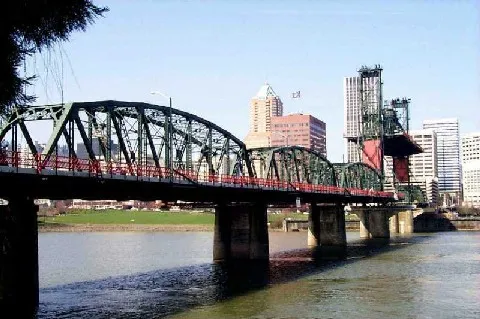
Vertical lift bridges use a system of counterweights and cables to move an interior lift span section that remains horizontal as it is raised up and down like an elevator, allowing river traffic to pass beneath the structure. The Hawthorne Bridge is the most prominent example of a vertical lift bridge.
Other examples in the Portland area are:
Burlington Northern/Sante Fe Railroad Bridge over the Willamette River near St. Johns
Union Pacific Railroad Steel Bridge in downtown Portland
Twin I-5 bridges over the Columbia River linking Portland to Vancouver, WA.
The average time for a span opening on the Hawthorne Bridge is only eight minutes, but the bridge operator gets a lot done in that short period of time!
After the operator, who works from a control room on the bridge, receives a request to open the bridge, they conduct a scan of the bridge to determine if there is traffic crossing the span. Then, they announce over the loudspeakers that the bridge will be opening, and begin the sequence of steps to prepare the span. Red lights mounted on the pedestrian and vehicle traffic gates begin to flash to indicate that the gates will be closing shortly. A warning horn begins beeping and remains on during the entire process. Traffic lights are used to stop vehicles from entering the lift span. Stripes and Walk/Don’t Walk signs are used to indicate safe zones for pedestrians. Other flashing lights mounted on the ramps to the bridge warn approaching vehicles that the lift span is opening.
Next, the operator lowers the vehicle and pedestrian gates which prevent traffic from entering the span. They then lower the gates on the exit lanes of the bridge. When all traffic is clear of the span, the operator opens the span locks to free the lift span from the piers. (The span locks keep the lift span from bouncing as traffic passes over it.) Two 150 horsepower motors turn the reduction gears connected to shafts and drums. These drums pull the operating ropes connected to the lift span and towers. The lift span is guided by rollers at each corner. These rollers prevent the lift span from moving sideways during the lift.
The tremendous weight of the lift span is balanced by the two concrete counterweights, located in the towers of the bridge. On the Hawthorne Bridge, each counterweight weighs approximately 450 tons and is connected to the lift span by 24 cables. Turnbuckles on the cables allow maintenance personnel to adjust the tension in the cables and the alignment of the counterweights to compensate for wear over time.
The operator can control the movement of the lift span by selecting a pre-determined height or personally manipulating the speed of the motors until the desired height is reached. Once the lift span reaches the desired height, the operator stops the motors, applies the span brakes and waits until the river traffic has passed beneath the span.
After the river traffic has cleared, the operator reverses the sequence and lowers the lift span down to its resting position on the structure. When the lift span is locked into position, the operation will raise the gates, turn off the horn and lights and allow street traffic to flow again.
